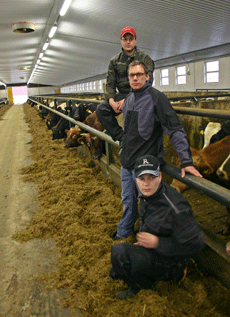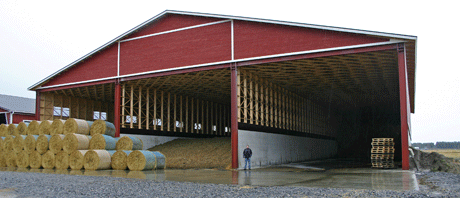Top stock management vital for Finland’s beef

Farming close to Arctic Circle is tough and requires a different approach to stock management.
With temperatures hovering around -30C in winter and an incredibly short summer growing season for crops, it seems like a miracle that anyone make a success of farming in the harsh Nordic climate of central Finland.
But the country’s beef and dairy enterprises are hardly second-rate. Milk yields across the county of Oulu regularly average 10,000-12,000-litres a cow and beef animals are usually finished within 18months.
Based close to the summer seaside resort of Kalajoki in the north of the Baltic sea, Juho Isopahkala runs a highly efficient dairy bull beef enterprise called Bullstop.
Two-week-old calves are collected from dairy farms within a 200km radius of two satellite units, one to the north and one to the south of Kalajoki. They are reared on milk replacer in groups of 50-60 and after six weeks are weaned on to a ration of grass silage and home-milled wheat.
They stay on the satellite farms for six months before they are moved on to the main finishing unit at Kalajoki.
Housed in ultra-modern climate-controlled buildings with slatted floors and 250mm (10in) of foam insulation for the roofs and walls, 1700 cattle are fed a carefully calculated diet according to growth stage and season.
“The ration is quite varied. We have a number of different energy sources to balance our grass and whole-crop silage which can fluctuate quite a lot in calorific value,” says Mr Isopahkala, pictured (centre), with contractors Ville-Matti and Juha-Pekka Vuollet, who handle the farm’s machinery work.

“It is a high energy diet to compensate for the cold in winter, but we have to be quite strict to avoid animals going overfat.”
To optimise rumen function straw is added at about 100g an animal a day and the farm uses 1200t of crimped wheat and barley each year. In addition 1500t of brewers’ grains and large quantities of potato peelings from a local processing plant help to top up the animals’ starch requirements.
The ration is mixed and dispensed with a Kuhn self-propelled horizontal auger feeder/mixer. All other operations – from slurry spreading to silaging – are handled by a contracting outfit which Mr Isopahkala holds a 25% stake in.
It generally takes about a year for cattle to reach their finished weight of 600-700kg (320kg target carcass weights). In that time each animal will have consumed the calorific equivalent of about 1.7t of rolled wheat. Without the alternative starch sources about 3000t of cereal-based feed would have to be bought in every year.
Because the unit takes in youngstock from a wide range of producers, herd health is a big issue at Bullstop.
“We are acutely aware of the disease risk and that’s the reason for quarantining the calves on the satellite farms for six months,” says Mr Isopahkala.
“We tend to pay more than market value for our calves to ensure we get the best, healthiest animals and we’re fortunate that the cold conditions mean that have very low disease levels.”
On arrival at the satellite unit the calves are de-horned with a vet present and receive a routine dose on antibiotic to stave off any infection. Government rules dictate that animals are tested for diseases such as salmonella before each group is moved to the fattening unit and again before they’re sent on to the abbatoir.

Bluetongue is unheard of and bacterial infections such as clostridia just don’t feature thanks to the frosty Finnish conditions. Similarly crop diseases are at a minimum and the farm’s arable area will generally only require a couple of passes from the sprayer.
But even though disease control may not weigh too heavily of the farm’s balance sheet, the hefty feed costs mean the enterprise struggles to clear a profit with beef prices in Finland at about €2.85/kg compared with €3.20/kg for the rest of Europe.
“Thanks to the dominance of two major supermarkets, prices are kept low. We can’t cover our costs even at this scale,” says Mr Isopahkala. “We’re heavily reliant on EU subsidies to keep going, which isn’t healthy.”
*For more information about the Finnish farming and food industries visit www.finfood.fi
Scandinavian subsidies
- Finnish farmers annually receive €320-350/ha for wheat crops, €400-420/ha for grass and €250 per beef animal.
Bullstop farm facts
- Location Kalajoki, west coast of central Finland
- Farmed area 600ha (1480acres)
- Stock 1700 dairy bull beef (mainly Holstein, Freisian and Ayrshire) plus 800 calves on two weaning units
- Staff Two full-time
- Machinery 18cu m Kuhn self-propelled feeder (all other operations handled by contractors)
